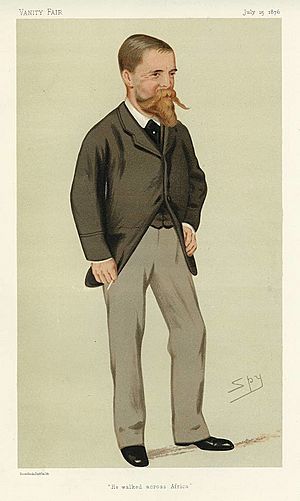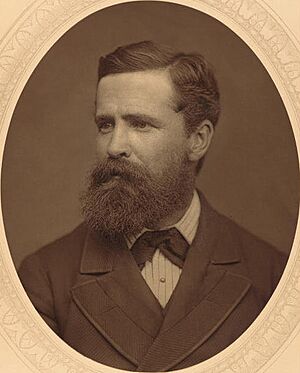Verney Lovett Cameron facts for kids
Verney Lovett Cameron (born July 1, 1844 – died March 24, 1894) was a brave English explorer. He was the first European to travel all the way across equatorial Africa from one side to the other, reaching the coast in 1875. This was a huge achievement for his time!
Contents
Cameron's Early Life and Adventures
Verney Lovett Cameron was born in Radipole, a small place near Weymouth, England. He joined the Royal Navy in 1857 when he was just 13 years old.
Fighting the Slave Trade
Cameron served in a war in Abyssinia (now Ethiopia) in 1868. After that, he spent a long time working to stop the East African slave trade. This experience taught him a lot about Africa.
Helping Dr. Livingstone
Because of his knowledge, Cameron was chosen to lead an expedition in 1873. This trip was organized by the Royal Geographical Society. Their main goal was to help the famous explorer Dr. Livingstone. Cameron was also told to explore new areas on his own.
Soon after the journey began from Zanzibar, Cameron's group met a caravan. This caravan was carrying the body of Dr. Livingstone, who had sadly died. Cameron's two European companions decided to go back to help bring Livingstone's body to the coast. But Cameron bravely decided to continue his mission.
Reaching Lake Tanganyika
Cameron kept going and reached Ujiji, a town on Lake Tanganyika, in February 1874. There, he found Dr. Livingstone's important papers and sent them back to England.
Cameron spent some time exploring the southern part of Lake Tanganyika. He discovered that the Lukuga River was the lake's outlet, which means water flowed out of the lake through this river. This was an important discovery!
Crossing Africa
From Lake Tanganyika, Cameron traveled west to Nyangwe. This was an Arab town on the Lualaba River. Dr. Livingstone had visited this river before. Cameron believed that the Lualaba River was actually the main part of the Congo River. He tried to get canoes to follow the river downstream.
However, Cameron refused to support slavery, which was common in the area. Because of this, he couldn't get the canoes he needed. So, he changed his plan and turned southwest.
A Historic Journey
Cameron then followed the path of the Congo and Zambezi rivers for hundreds of miles. He finally reached Bihe and arrived at the coast on November 28, 1875. He was the first European to cross equatorial Africa from one side to the other!
For his amazing journey, Cameron received the Founder's Medal from the Royal Geographical Society in 1876.
After the Great Journey
Cameron wrote a book about his travels called Across Africa. It was published in 1877. In his book, he shared ideas on how to develop Africa. He suggested using the large lakes as part of a connection from Cape to Cairo. Because of his important work, he was promoted to the rank of Commander in the Navy.
After his big journey, Cameron spent most of his life working on projects to help Africa grow. He also edited and wrote books. He even helped edit a book about a sailor named James Choyce. This book told about Choyce's 26 years of adventures at sea.
In 1878 and 1879, Cameron visited the Euphrates valley. He was looking into a plan for a railway to the Persian Gulf. In 1882, he traveled with Sir Richard Burton to West Africa. On the Gold Coast, Cameron explored the Tarkwa region. He and Burton wrote a book together called To the Gold Coast for Gold (1883).
Cameron also wrote several adventure books for boys in the 1880s. He was inspired by his sister-in-law, who wrote romantic stories.
Sadly, Verney Lovett Cameron died in 1894. He fell from his horse while hunting near Leighton Buzzard. He was married to Amy, the daughter of William Morris from Jamaica.
A new version of his book Across Africa was published in 1885. It included new information and updated maps. A summary of his great journey can also be found in a book called The Story of Africa by Dr. Robert Brown. Across Africa was published again in 2005.
Books by Verney Lovett Cameron
- The Cruise of the "Black Prince" Privateer (1886)
- In Savage Africa (1887)
- To The Gold Coast for Gold: A Personal Narrative. Vol. I, II (1883)
- Among The Turks (1890)
See also
 In Spanish: Verney Lovett Cameron para niños
In Spanish: Verney Lovett Cameron para niños



